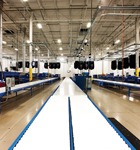Anyone who has endured a hospital stay understands the importance of clean linens for a patient’s comfort and speedy recovery. For Crothall Laundry Services, a new energy-efficient laundry with room for growth was the prescription for making sure the firm could continue to provide fresh sheets and towels to medical facilities throughout the greater Milwaukee area.
Crothall’s new 83,000-square-foot, $13 million plant in suburban Oak Creek, Wisconsin, is the first LEED-certified laundry in the world and has the capacity to process 50 million pounds of linens per year. It also is the first laundry that the national healthcare support-services provider built from the ground up. The project took just one year thanks to a partnership with CenterPoint Properties, a Midwest-based national developer with the construction and design expertise—and the property in its portfolio—to deliver the facility. Here’s a look at the key elements that went into its design.
1/ Process
Crothall Laundry Services processes 18 million pounds of healthcare linen annually from various hospitals in the Milwaukee area, and that volume requires a steady, orderly flow from delivery trucks; through the wash, dry, and sorting stages; and back out to the trucks. The new plant employs three tunnel washers, with PulseFlow technology, from Pellerin Milnor Corp., and, on average, they operate at a water-consumption rate of approximately 0.45 gallons per pound of laundry. For Crothall, that represents an annual water-usage savings of 8.5 million gallons—or, 39 percent less consumption than that of traditional tunnel washers. Another efficiency innovation is the generation of hot water using natural, gas-fired hot-water boilers—with heat exchangers that recover heat from wastewater—rather than more typical high-pressure steam boilers.

Crothall Laundry will save 8.5 million gallons of water this year. Such savings are possible through efficient design and tunnel washers with PulseFlow technology from Pellerin Milnor Corp. Photo: McShane Fleming Studios.
2/ Systems
The laundry needed to have both highly efficient equipment and energy-efficient building systems. “It’s a pretty straightforward industrial building, but we used cutting-edge technology for the HVAC and plumbing systems,” says Paul Schmitter, CenterPoint’s development manager for Wisconsin. “We modeled all of the building systems with the laundry equipment. We established a baseline model with standard laundry equipment, and then we compared that to a model with high-efficiency laundry equipment. We were able to show a 20 percent savings in energy consumption with the high-efficiency equipment, and that is what Crothall ultimately chose and installed. As a result, it is not just a LEED-certified building; it’s a LEED-certified facility.”
3/ Location
When Wisconsin’s Aurora Healthcare needed to convert its existing Crothall-operated laundry for another use, the search began for a location that would enable the new laundry to continue processing 18 million pounds of linen annually from 17 hospitals in the region. “Crothall came to the marketplace with the project and interviewed a number of developers before awarding it to CenterPoint,” Schmitter says. “One of the factors in our favor is that the property is within a mile of Interstate 94, which provides easy access to the greater Milwaukee region.”
4/ Aesthetics
The facility, located on 5.64 acres within CenterPoint’s Creekside Corporate Park, had to meet the design standards of the City of Oak Creek. Featuring a light gray and white exterior with dark blue accents and attractive landscaping, the tilt-wall concrete building blends in well with adjacent warehouse and distribution facilities. “It’s a pleasing building as industrial facilities go,” Schmitter says.
Crothall is leasing the property from CenterPoint—recently named “Developer of the Year” by the NAIOP Commercial Real Estate Development Association—and CenterPoint is pleased to have the laundry in its portfolio, which totals 27.8 million square feet of warehouse, distribution, and light-industrial space in Illinois, Wisconsin, and beyond. “We’ve completed highly advanced projects like this before,” Schmitter says, “and this successfully reinforces our track record.”

